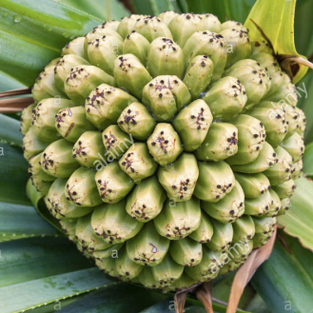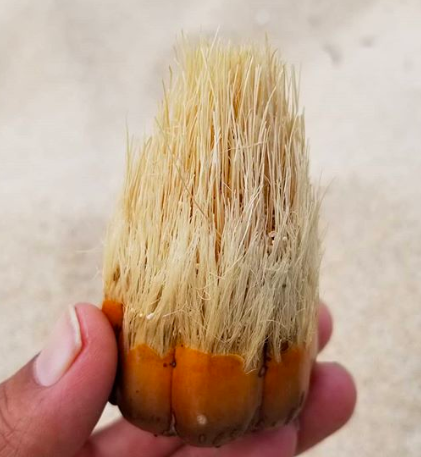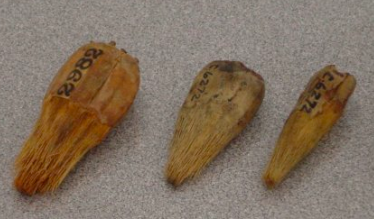Lauhala Introduction
- Kaiya-lynn Kaha

- Aug 27, 2019
- 4 min read
Updated: Nov 4, 2019
Hala is a strong and durable material used by many Polynesian cultures to make a variety of things. In ancient Hawaii, Hala was used to line the inside of houses, for mats, clothes, baskets, and even sails.
It can be found almost everywhere, from sea level all the way to 2000 ft. Trees can grow up to 30 ft tall and can span 20-40 feet wide. In the moʻolelo "Ka Hala Lau o Waiku" it explains the reasoning for why this tree is so widespread in the Hawaiian islands.
"Ka Hala Lau o Waiku"
When Pele, the goddess of the volcano and fire, first arrived to the Hawaiian islands her waʻa (canoe) got tangled within the Halaʻs tree roots. Hot-tempered, and angered by the trees rude greeting, Pele tore the plant into pieces and casted them into the 4 winds. The winds carried the plant to all four corners of the islands and hence the reason why it is so prevalent in Hawaii.
Anatomy Of Hala:
Plant
Puhala: The tree
Kumu Hala: Trunk
Puʻupuʻu Hala: Growths found on trunk
Uleule Hala/Ule Hala: Roots above the ground
Aʻa Hala: Roots under the ground
Leaves
Lauhala: Leaf
Poʻolau: Butt end
ʻElelau/Welelau: Tip end
Kua (kuakua): Midrib
Kokala/Kakala: Thorns
Muʻohala: Sprouting leaves
Fruit (female)
ʻAhui hala: Whole fruit
Hala: Single key
ʻIʻo hala: Flesh of fruit
Iwi hala: Seed
Flower (male)
Hinano: Flower
Ehu Hinano: Pollen
Hinano/Hinalo: Bracts
Type Of Fruits:
There are many different type of Hala Fruit classified by native Hawaiians and is recognized by their color, size, and fruit. These types include:
Hala ʻula: Deep orange red fruit.
Hala lihilihi ʻula: Fruit with a red top that lightens to yellow towards the center.
Hala ʻīkoi: Keys 7 cm long with a lemon-colored at base. It has an abrupt change to a bright-orange in the upper half of the fruit; when cut for leis, a rim of orange is left at top of each key used.
Hala melemele: Solid yellow fruit.
Hala pia: Off-white, very small fruit.
Hala ʻiʻo: A pandanus key that is ripe and soft, suitable for leis.
Hala iwi nui: Hard pandanus key, not suitable for leis. (hard-appearing and dissatisfied.)
Hala maoli/hala melemele: A common form of pandanus with bright yellow keys.
Hala pia: An indigenous variety of pandanus, with keys 4 cm long, canary-yellow and small; head small, about 15 by 12 cm. Used in medical prescription and for exorcising evil spirits. It was much prized for leis.
These fruit can be made into beautiful lei and even eaten by some cultures. However because Hala can mean failure or end, people avoid giving leis made of hala to a person going on an important trip or traveling to distant places, for fear he may not succeed or return home.
To eat a fresh hala fruit, use the claw of a hammer to remove a couple of the keys. The rest should pop out easily. Chew on the center of each key to break down the fibers, then suck out the sweet nectar inside. Small-fruited hala may be more bitter and astringent than larger varieties. While green fruit is inedible.
Some cultures also use the leaves of the hala tree to prepare their food. Leaves can be placed in cooking liquid to add flavor (and removed after cooking) or boiled until soft. The leaves have a sweet flavor and aroma; it is often used in soups and stews.
Screw Pine Leaves add a green coloring to food. They can also be added to rice as it is cooking, boiled with water for a drink, or used as a flavoring in desserts, and used as a wrapper for cooking more food in.
It is said that hala helps to restore health, strength, and the well-being of a person due to the carbohydrates and proteins in the fruit.
Types of leaves:
Hawaiians classified the leaves from ascending order.
Paʻilauʻula: Older leaves that are found lower on the tree (Good for ordinary mats)
Laʻele: Above Paʻilauʻula are found Laʻele which are green and tough (too hard for detailed mats)
Pili Laʻele: Dark green with white bases (too hard for detailed mats)
Koʻo: Light green (good for intricate mats)
ʻIʻo Koʻo: Nearly all white excluding the tips (great for intricate mats)
Pukani or muʻohala: Unopened leaves that are all white, very flexible, and found at the clustered center of a tree. (great for making intricate mats named ʻahu in Puna)
(From Lily Akana of Puna, Hawaii)
The names of these plant parts may differ depending on what district a person is from.
Uses:
Aphrodisiac
Other than weaving and eating, Lauhala was used as an aphrodisiac. While female plants produced lovely fruit for eating, leis, and other items, the male plant produced a yellow pollen. This substance was used by ancient Hawaiians. It would be scattered on their clothes, beds, and bodies which acted as a type of perfume. It is also believed to help stimulate sexual desire.
More on the Hinano Flower :
The oils extracted from the flower of the hala tree (Hinano) can also be used to treat headaches, earaches, and rheumatic pains. It was also used in cooking for flavor and was chewed on which acted as a breath freshener
Paintbrushes
Paintbrushes can be made out of the fruit from the hala tree. After eating all the nectar from out of the fruit (which tastes like mango and cantaloupe) the part of the fruit which is attached to the main base with all the fibers could be used to draw and paint with. To spread apart and create more fibers, the fruit can be swept on a wire brush.
Another way it can be processed into a paint brush is by roasting, pounding, and then ringing it out. It is often thought that the best hala paintbrushes come from the washed up fruit that are stirred and worked by the ocean currents.
To make a more modern looking paintbrush you can insert a long screw at the fat end (where there are no fibers). This will create a handle. If you want to create an even more comfortable handle, you may take some strips of lauhala and wrap it around the screw. Thus adding padding for your hand.
Medicine
Medicine can also be made out of the aerial root (uleule) of the Hala tree. This medicine is usually prepared by smashing and cooking the tips of the hala root in ti leaves. The root is rich in vitamin B but has a pungent-bitter taste.
Click this link to direct you to a video on how to prepare Lauhala for weaving: https://kahacreations.wixsite.com/website/post/lauhala-searching-collecting-and-preparation-process




















Comments